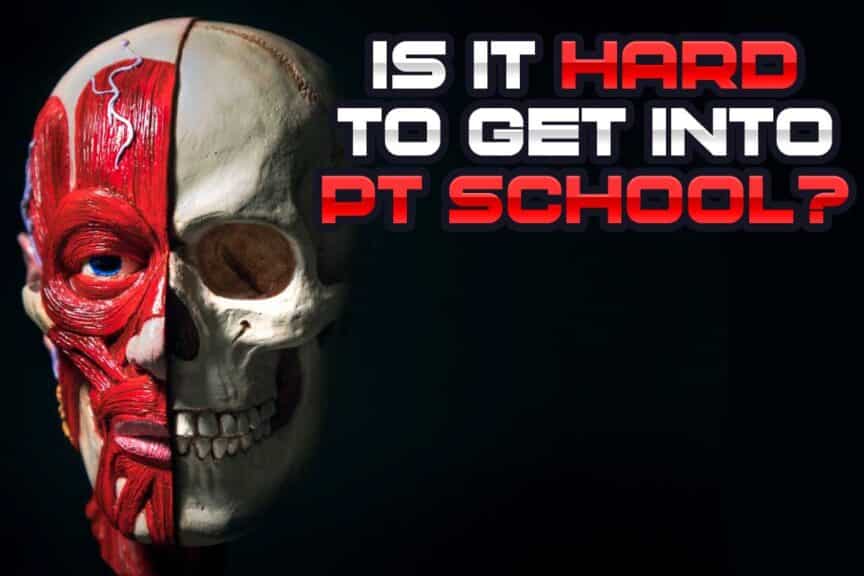If you’re wondering if it’s hard to get into PT school, I’ve got you covered within this article. I’ll be giving you ALL sorts of facts that will help you understand the potential challenges that you may be up against if you’re wanting to get into PT school. But, don’t worry, getting into a PT program is entirely possible and a lot easier to do when you know what you’re up against.
While it’s statistically challenging to get into PT school (around a 16% acceptance rate), it’s a lot easier when you are certain of the requirements and know what you’re up against in terms of your competition. Many applicants don’t get accepted simply because they don’t meet the mandatory requirements of the schools they apply to.
If you want my quick, honest insight, it’s this: Getting INTO PT school is the hardest part of the whole entire thing. It took me three years to get accepted, but once I got in, I crushed every aspect of school, including writing and passing the national board exam (NPTE) three months ahead of standard timelines. Many other friends of mine have also expressed that their story is identical to mine in this regard. So, if you can get in, it MAY just be that the hardest part is already over.
A quick overview of important facts for getting into PT school
Here are the quick facts I’ll be going over within this article:
- The average number of applicants and the average acceptance rate for PT school
- The average GPA requirements to get into PT school
- The typical prerequisite course requirements for PT school
- The average GRE Score requirements for PT school
- The average number of volunteer hours in PT clinics required of applicants
- Getting through the formal PT school interview
These facts will be discussed in high levels of detail below, so be sure to keep reading.
Related article: Ten Reasons to Become a Physical Therapist for Your Career
Also, I will be referencing a particular document quite frequently throughout this post. The document is the 2019-2020 Aggregate Program Data Report by the CAPTE (the link will open up the PDF document from their website). This is the authoritative resource for all things pertaining to nationwide statistical data for all PT schools that are accredited institutions. Click the Aggregate Program Data Report link above if you’d like the PDF copy of all these statistics.
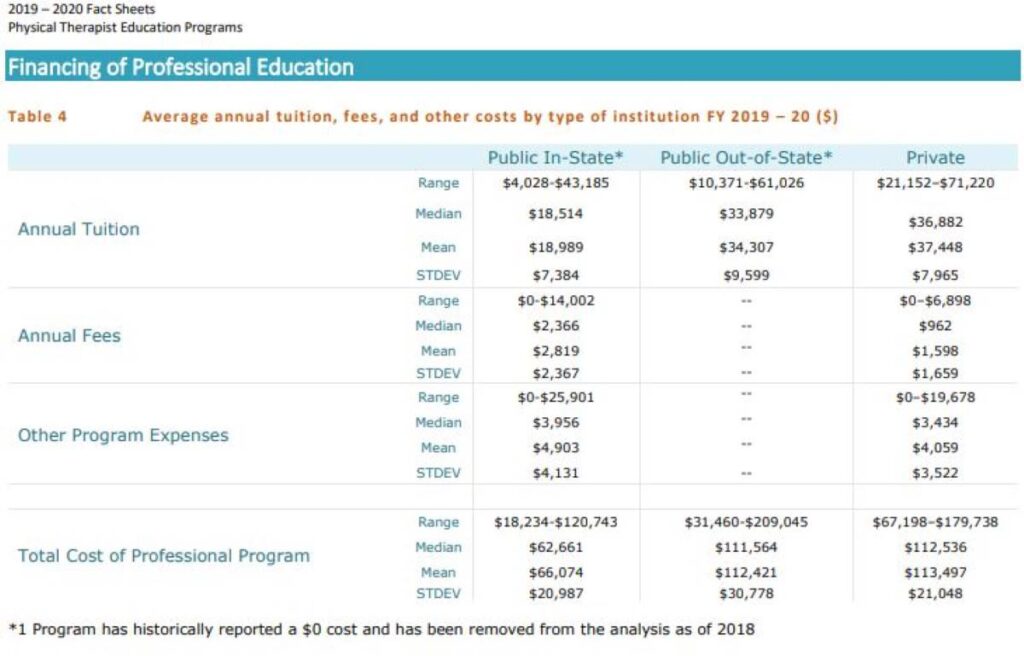
The average number of applicants and the average acceptance rate
One of the most central factors for determining how “hard” it is to get into PT school is knowing how many applicants you’re up against, and what percentage of all qualified applicants wind up getting accepted to a PT program.
When referencing the CAPTE’s report, here are the average (mean) numbers across all PT schools within the US for 2017, 2018 and 2019:
Now, there’s a lot to take away and dissect from this chart but let’s just start off with the average number of applicants and the average acceptance rate.
Many individuals who apply don’t actually meet the eligibility requirements
When looking at the chart and for the year of 2019, the FIRST important distinction to make is that there is a large number of applicants who apply to PT school (440 applicants per school, on average) but 159 of them (on average) who aren’t actually qualified (i.e. they don’t meet the baseline requirements of that particular school).
While there are 92 applicants on average per school that are ultimately offered a place within that school’s PT program, those 92 applicants are selected from the total number of QUALIFIED applicants (281, on average), not the collective grouping of the 440 qualified and non-qualified applicants.
This is an important distinction to make since there are on average 159 unqualified applicants (440 – 281 = 159) who didn’t meet the application requirements of a PT program. To say that only 10% of all applicants wind up finding a seat within a PT program (45/440 =10%) is a bit misleading since many of them were never even qualified to begin with.
Rather, you should consider the total number of applicants who ARE qualified and find a seat within a PT program. This works out to 16% of applicants ultimately taking a seat within a PT program since acceptance rates should be based on those who were qualified applicants.
Related article: How to Succeed in PT School (Don’t Make These Mistakes)
So, we have our first major starting point for determining if it’s “hard” to get into PT school: Of all the qualified applicants applying for PT school, the average percentage of students who ultimately take a seat within a PT program is 16%.

The average GPA requirements to get into PT school
Now, the next important number to consider when looking at the characteristics of accepted applicants is their undergraduate grade point average (GPA). Again, if we look at the chart data from the CAPTE’s report (the table listed above), we can see that the mean (average) undergraduate GPA of those accepted into a PT program for 2019 was 3.58 (on a 4.0 scale).
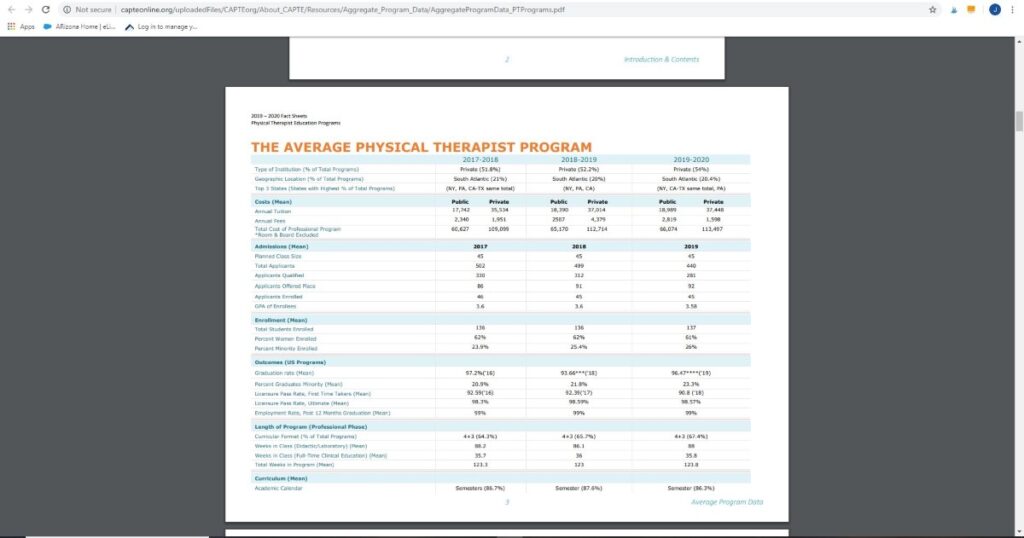
One important note: Many PT schools require a minimal GPA for undergraduate prerequisite courses AND a minimal overall undergraduate GPA. The CAPTE’s report does not specify whether the GPA data in the chart is an overall GPA or not. I would assume that it is, but it’s not specified.
Assuming that the mean GPA listed in the report is an overall GPA, this means that you’ll likely need to be an “A” student when it comes to course grades in your undergraduate studies. You don’t need to be a “straight A” student, but you’ll want most of your courses to be around A- territory to be safe.
A personal note: I had a couple of B+’s on my transcripts in my prerequisite courses, and while my overall GPA was around 3.5 (after 2 years of upgrading), I still managed to get accepted into PT school.
Whether you consider it “easy” or “hard” to get around a 3.5 overall GPA in your undergraduate degree (including all your necessary prerequisite courses for PT school) is up to you. Personally, I admit that getting this type of GPA in all sorts of science-based undergraduate courses is by no means an “easy” task (at least for me it wasn’t), but it is doable under the right circumstances so long as you’re willing to work hard.
The average GRE Scores for getting into PT school
When it comes to looking at the required Graduate Records Examination (GRE) scores, there is no data within the CAPTE’s report to mention or show what the average GRE score is for accepted students. But, it’s pretty easy and straightforward how to figure out some basic data around these scores.
First, you need to understand that not every school requires you to write the GRE in order to apply to that school’s particular PT program. It would seem, however, that the majority of them do.
Now, when it comes to knowing what the required scores are, it’s best to just look at the individual school(s) that you’re thinking of applying to. This is actually really easy and straightforward to do.
All you have to do is go to the PTCAS program directory list (link will take you to their directory list on their site) and click on the link to either gather a list of PT schools either by state or by program name. From there, just find the name of the school you want, click on it and it will give you a breakdown of all sorts of information, including whether or not you need to write the GRE for that school, and if so, what the required scores are that you’ll need. The page will even give you the school codes that you’ll need for sending your GRE scores to them.
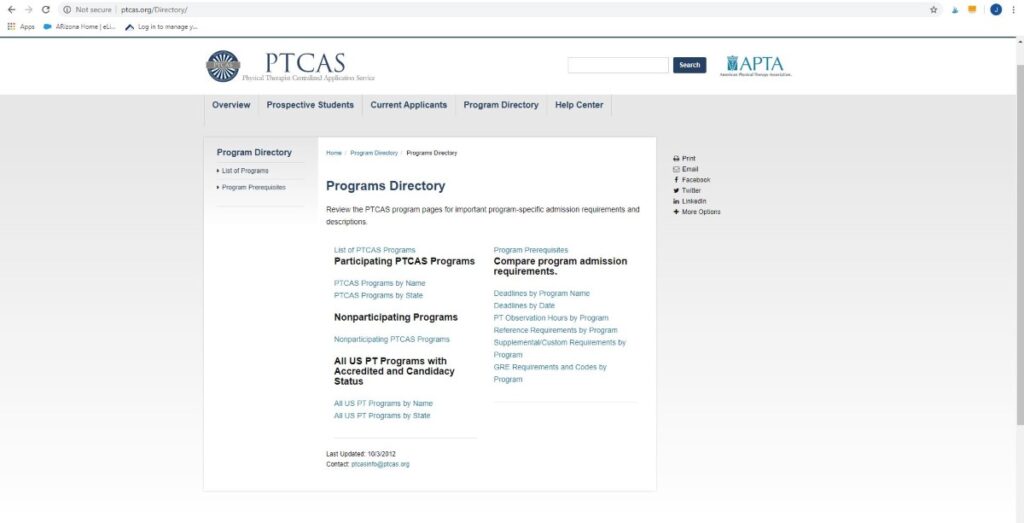
The GRE has no correlation towards how well you’ll do in PT school
I want to quickly mention that the GRE exam has no correlation as to whether or not you’ll be a great PT student or successful physical therapist. It’s just a hoop you have to jump through for some schools. I found it to be an extremely challenging exam for me on the mathematical aspects, but I killed PT school.
Don’t ever for a second think that the GRE is any indication of how good you’ll do in PT school — it’s just a hoop you, unfortunately, have to jump through for some schools in order to get in.
I took the GRE twice. Math is not my strongest area and so I had to work hard on getting decent scores for that category. As always, I slayed the non-mathematical parts of the exam but always felt like the mathematical parts actually slayed me.
The Typical prerequisite course requirements for PT school
If you’re planning on attempting to get into PT school, you need to be aware that there are a specific number of prerequisite courses that you must fulfill within your undergraduate studies.
Note: Your undergraduate degree or your major does not matter, so long as you’ve simply completed all the prerequisite coursework and done so with acceptable grades for the school(s) that you’re considering applying to.
If you’d like extended detail on what these courses are and what each one of them entails, I have an extensive blog post written in which I break all of this down, which you can find here: What Prerequisite Coursework is Required for PT school in the US?
Here’s the super quick rundown from that post that you need to know:
- EVERY school requires coursework in anatomy and physiology
- 98% of schools require two courses of chemistry (with lab components)
- 98% of schools require two courses of physics (with lab components)
- 89% of schools require at least one course in biology (with a lab component)
- 93% of schools require at least one course in psychology
- 95% of schools require one course on introductory statistics
In addition to these largely universal prerequisite courses, each school may have other additional coursework that they also require. If you want to know the specific requirements that each school is looking for, you can either use this PTCAS PDF document (link will take you to the PDF on their website) to help you quickly locate the requirements for the school(s) you’re considering, or you can use their website’s program list to locate the school(s) you’re interested in and get a complete breakdown of all the requirements they want you to meet.
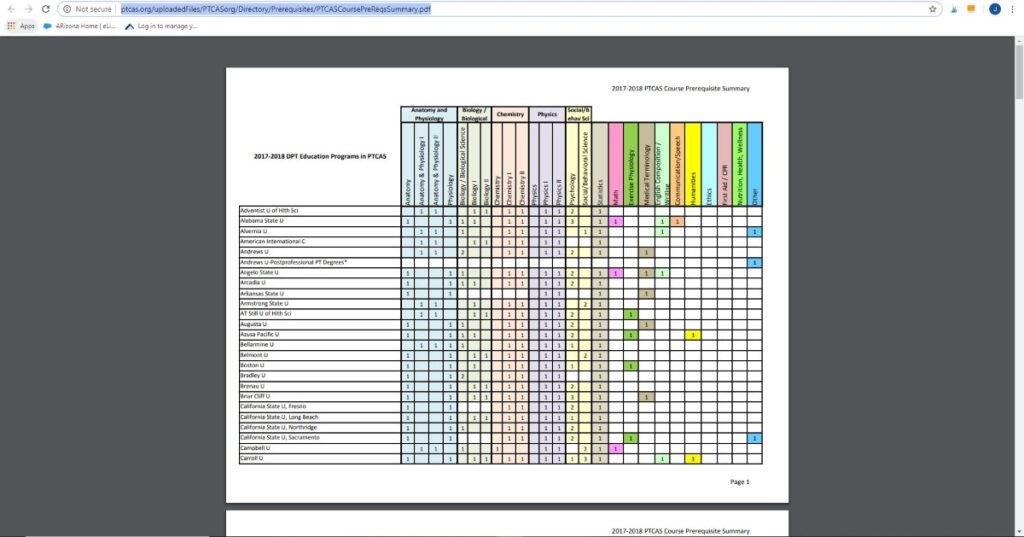
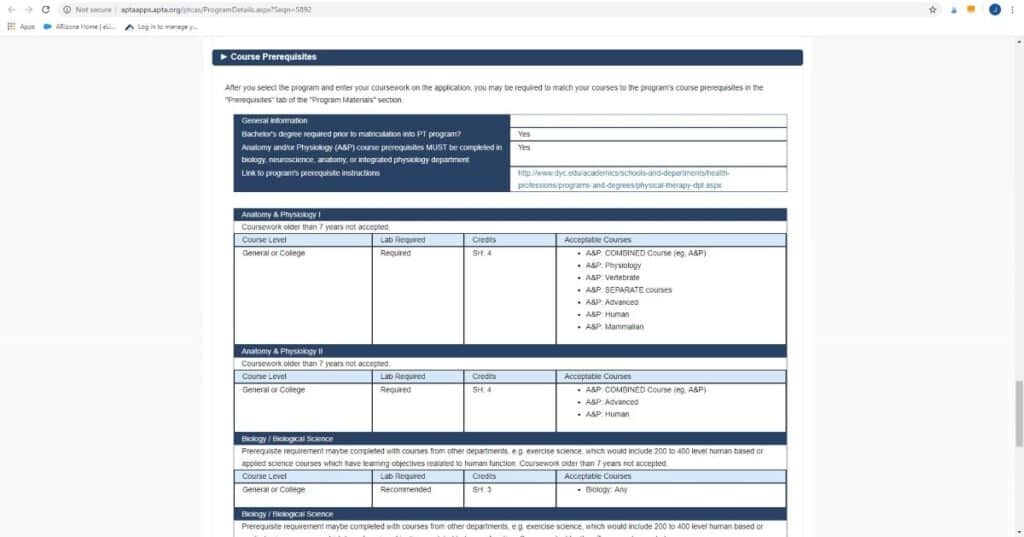
Finding specific requirements for the school(s) you’re looking to apply to
With every PT school having slightly different requirements, you need to be absolutely certain that you have met all the necessary course prerequisites (and minimal grades) set out by any PT school that you’re applying to.
This is actually a rather quick and easy thing to do and just requires you to look up the school-specific requirements on the Physical Therapy Centralized Academic Service website (PTCAS).
The average number of volunteer hours in PT clinics required of applicants
If you’re not aware, a large portion of PT schools requires their applicants to complete a specified number of hours observing in one or more PT clinics before applying. These hour requirements are different for every school and some schools don’t even require them. Of the schools that do, some of them require those hours to be verified while others don’t.
I wrote an extensive blog post on this topic, where I analyzed and broke down the average number of volunteer hours that PT schools across the US are requiring applicants to fulfill as part of the application process. You can access that blog post here: PT School Observation Hours: How Many are Needed for Applicants?
The quick takeaway from that article is that I found that the mean observational hour requirements across 238 PTCAS-participating schools are 54.5 hours. Non-PTCAS clinical observational hour requirements were not included in my analysis.
While volunteering/observing in PT clinics is usually quite straightforward, it can sometimes be challenging or hard to find clinics to amass these hours in, especially if you don’t know any physical therapists or have any personal connections in any way.
If this is the case, this can be one of the added factors that can make it more challenging to get into school, especially if your school requires that these hours be verified (signed-off on) by the physical therapist(s) who saw you complete those hours.
If you need help on how to find clinical observation hours, be sure to check out my article: How to Find Clinical Observation Hours for PT Application Requirements, as it will give you some solid tips on how to locate clinics for completing your required volunteered hours. It’s also got insight on how to ask those clinics to spend some time with them in case you’re not sure how to ask to volunteer with them.
Getting through the formal PT school interview
One other hurdle that applicants oftentimes need to clear is a formal interview with a PT school that has requested them to attend. Not every school has an interview process, but for the schools that do, it becomes one more step that the applicant must go through in order to potentially get an invite to have a seat in the program.
The interview itself can be conducted in slightly different manners, depending on the school. While you want to take every step that you can to ensure a great interview, there will always be a large portion of the outcome decision that is simply out of your hands. This in itself just serves as one more challenge for all applicants wishing to get into PT school.
If you want to learn some great tips to help ensure you make the best impression possible during your interview, be sure to check out my blog post: Five Top Tips on How to Achieve A Successful Interview for PT School
While you want to have the best interview possible, you need to remember to surrender your control afterwards, as it’s out of your hands after that point — this can be hard for applicants to do, myself included. I had one interview at a school that I was confident I had dominated but was shocked a few weeks later when I got a letter in the mail saying I wasn’t admitted into the program. That was hard news to take.
Concluding remarks
While the word “hard” can have individual interpretation and semantics revolving around the context of “getting into PT school”, the easiest thing to say is that there are a lot of hoops to jump through if PT school is something you’re considering.
These hoops are where I perceive the vast majority of the “hardness” to come from for getting into PT school. Yes, you need a lot of prerequisite coursework, but you also need to meet a lot of additional criteria around a GPA north of 3.5, writing an exam (the GRE) that has no bearing on how well or not you’ll do in PT school and getting through a formal interview if your school requests one.
Thankfully, your odds increase drastically if you simply meet all the baseline requirements that schools ask of you – looking at the data earlier in this article that many applicants don’t make it in simply because they don’t meet eligibility requirements. So, simply ensuring you meet the requirements already puts you on much better ground than a lot of applicants who get rejected.
The bottom line: There are challenges for getting into PT school, yes. It’s not necessarily easy, but it’s entirely possible if know that you want to work for it and meet the application requirements. So, if your heart is set on PT school, know that I’m rooting for you and that the harder something is to obtain, the sweeter it tastes when you get it.
Grind hard. You got this.

Hi! I’m Jim Wittstrom, PT, DPT, CSCS, Pn1.
I am a physical therapist who is passionate about all things pertaining to strength & conditioning, human movement, injury prevention and rehabilitation. I created StrengthResurgence.com in order to help others become stronger and healthier. I also love helping aspiring students and therapists fulfill their dreams of becoming successful in school and within their clinical PT practice. Thanks for checking out my site!

